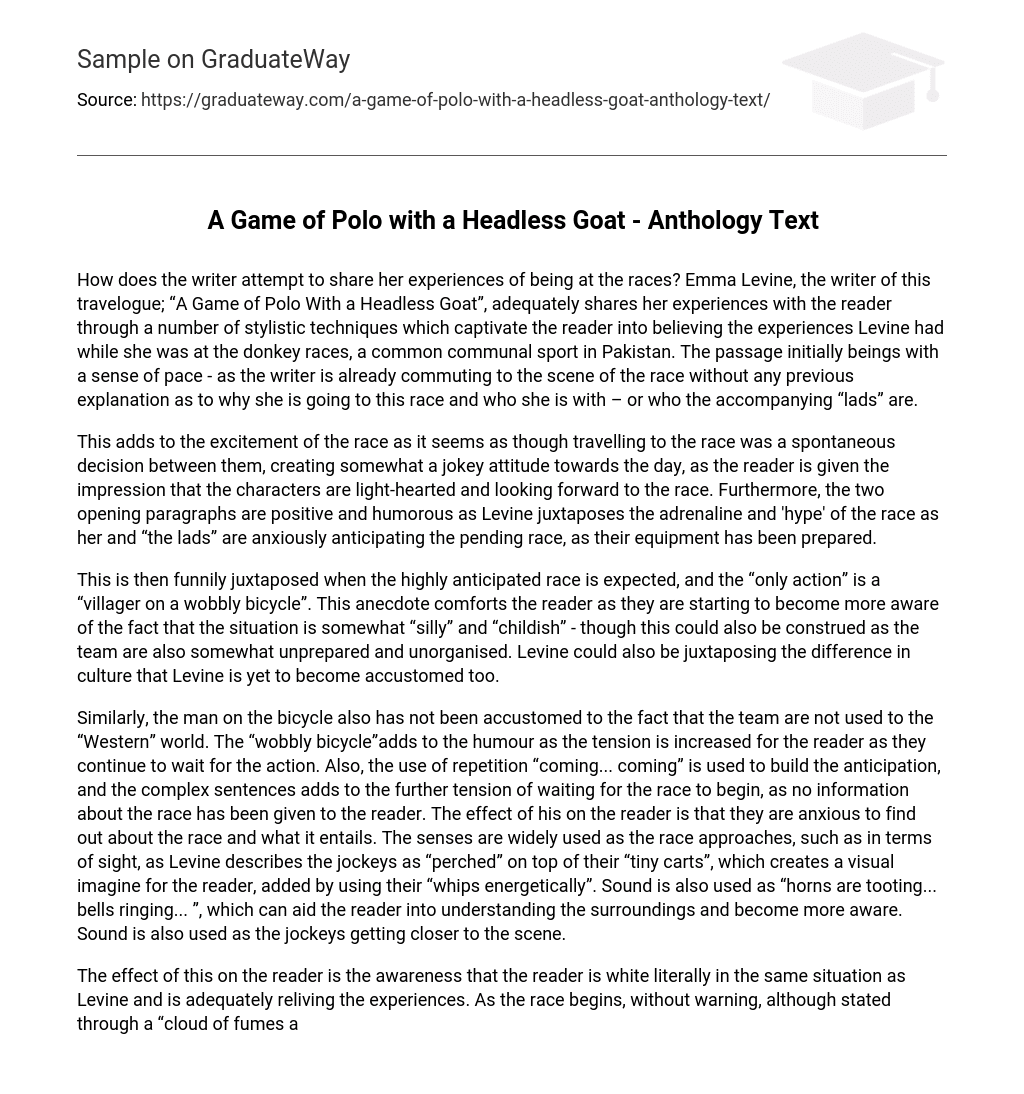How does the writer attempt to share her experiences of being at the races? Emma Levine, the writer of this travelogue; “A Game of Polo With a Headless Goat”, adequately shares her experiences with the reader through a number of stylistic techniques which captivate the reader into believing the experiences Levine had while she was at the donkey races, a common communal sport in Pakistan. The passage initially beings with a sense of pace – as the writer is already commuting to the scene of the race without any previous explanation as to why she is going to this race and who she is with – or who the accompanying “lads” are.
This adds to the excitement of the race as it seems as though travelling to the race was a spontaneous decision between them, creating somewhat a jokey attitude towards the day, as the reader is given the impression that the characters are light-hearted and looking forward to the race. Furthermore, the two opening paragraphs are positive and humorous as Levine juxtaposes the adrenaline and ‘hype’ of the race as her and “the lads” are anxiously anticipating the pending race, as their equipment has been prepared.
This is then funnily juxtaposed when the highly anticipated race is expected, and the “only action” is a “villager on a wobbly bicycle”. This anecdote comforts the reader as they are starting to become more aware of the fact that the situation is somewhat “silly” and “childish” – though this could also be construed as the team are also somewhat unprepared and unorganised. Levine could also be juxtaposing the difference in culture that Levine is yet to become accustomed too.
Similarly, the man on the bicycle also has not been accustomed to the fact that the team are not used to the “Western” world. The “wobbly bicycle”adds to the humour as the tension is increased for the reader as they continue to wait for the action. Also, the use of repetition “coming… coming” is used to build the anticipation, and the complex sentences adds to the further tension of waiting for the race to begin, as no information about the race has been given to the reader. The effect of his on the reader is that they are anxious to find out about the race and what it entails. The senses are widely used as the race approaches, such as in terms of sight, as Levine describes the jockeys as “perched” on top of their “tiny carts”, which creates a visual imagine for the reader, added by using their “whips energetically”. Sound is also used as “horns are tooting… bells ringing… ”, which can aid the reader into understanding the surroundings and become more aware. Sound is also used as the jockeys getting closer to the scene.
The effect of this on the reader is the awareness that the reader is white literally in the same situation as Levine and is adequately reliving the experiences. As the race begins, without warning, although stated through a “cloud of fumes and dust”, Levine and the “lads” (who we are still unaware of). Interestingly, the humour and jokey attitude before the race has been replaced with a somewhat different “persona” and serious followers are now becoming very dedicated to the race.
The slow pace of the opening has now been contrasted with the speed of the donkeys and their “jostling” for position in the race, which can be construed as a thought that the race is quite unorganised and there is no “form”, and is similarly compared to the “Formula One without rules. ” The sense of detached amusement the writer feels about the race beforehand has been displaced by a real interest in the donkeys, as the pace is heightened as the slow start of “inching into the traffic” is soon replaced by “rush hour gone anarchic”.
The obvious effect of this on the reader is the prominent juxtaposition of the metaphorical “traffic” reference, that the traffic before the race was quiet as no-one was particularly interested in the race, but because it’s started, the traffic has changed and spectators are a lot more serious than they were before. Finally, the character of “one of the lads” is developed when we are introduced to Yaqoob and his “nerves of steel”; explaining his obvious enjoyment of the race. The writer’s excitement builds as the speed further increases towards the end of the race.
The use of abrupt, short sentences following the end of the race is explaining the sudden change in atmosphere; the situation is now no longer humorous or exciting, but has the potential for danger as the characters are in a volatile situation. This changes the effect of the reader as they are unsure of how to “feel” as the pace has so suddenly changed, as the mysterious potential for danger is prominent, as the characters are in a volatile situation where they are unsure of how to feel in the situation, adding to the suspense of the uncertainty.
Finally, the passage comes to a full circle as the humour finally arises as Yaqoob admits that he does not have a drivers license, which is similarly contrasting again the cultural differences – the no license does not seem to as such of a big deal to the drivers of the donkeys, yet is an anecdote to highlight Levine’s experiences of being at the races for the reader’s benefit. Overall, there are many different techniques used to portray the experiences at the races, which highlight the many different emotions and feelings Levine was having.





